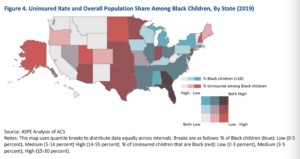With the implementation of the Affordable Care Act, the percentage of Black Americans who lack medical insurance has fallen significantly with the percentage of Black Americans who were uninsured decreasing by 8 percentage points from 2011 to 2019. Unfortunately, when compared to White populations, percentages of Black Americans uninsured are still comparatively high.
Further, this progress towards equitable health care access largely depends on where people live, as shown by a new report from the Department of Health and Human Services. Many Southern states have been reluctant to take part in necessary provisions which enable the expansion of coverage to millions of Americans previously with little or no access to medical insurance. “Nearly 1 million Black American adults would become eligible for medical insurance if 12 holdout states expanded Medicaid eligibility under the ACA, according to the HHS report” (Akilah Johnson, Washington Post).
Under the Biden-Harris Administration, legislative and administrative actions have been forwarded to expand affordable coverage options; “Under the American Rescue Plan (ARP), which increased health insurance Marketplace subsidies, 76 percent of uninsured Black Americans could find a plan for less than $50 a month and 66 percent could find a plan for $0 a month in 2021” (Assistant Secretary for Planning and Evaluation). These changes are increasingly urgent as the pandemic is only exacerbating existing health disparities and inequities in access to affordable care for the Black population.
Looking at Black Children specifically, the following Figure from ASPE Office of Health Policy shows state-level percentages of Black children under 18 as well as the uninsured rate among Black children. It should be noted that “Florida and Georgia, states that have not expanded Medicaid, both have high percentages of Black children and a high uninsured rate among Black children in 2019.” (ASPE).

